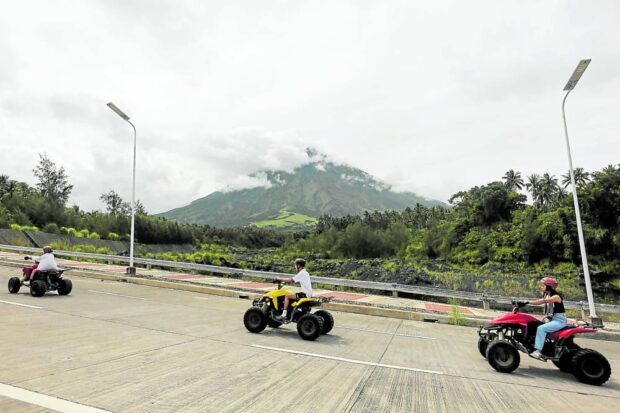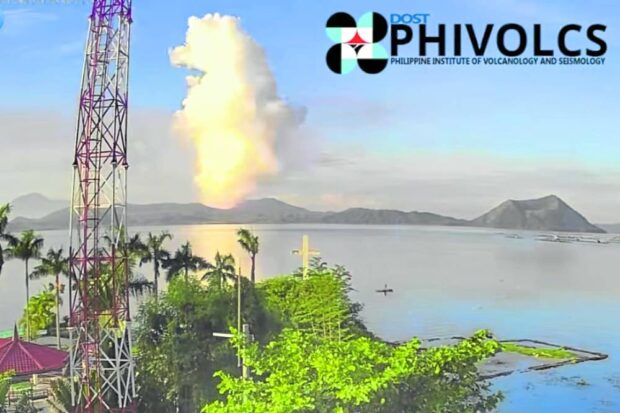‘Increasing unrest’ in Mayon, Taal; residents relocated

ADVENTURE RIDE | The Philippine Institute of Volcanology and Seismology places Mayon Volcano under alert level 2 after its monitoring of the summit crater shows an increased rockfall. On Monday, several tourists are seen still enjoying all-terrain vehicle rides in Daraga, Albay, as clouds obscure the view of Mayon. (Photo by MARK ALVIC ESPLANA / Inquirer Southern Luzon)
LEGAZPI CITY, Albay, Philippines — Farmers near Mayon Volcano in Albay province and residents around Taal Volcano in Batangas province were advised to keep out of the danger zones of these two active volcanoes following their “increasing unrest” since Sunday.
In a bulletin on Monday morning, the Philippine Institute of Volcanology and Seismology (Phivolcs) raised the warning signal over Mayon to alert level 2, indicating the possibility of phreatic, or steam-driven, eruptions or hazardous magmatic eruptions.
Mayon’s rockfall events also rose from a daily average of five in April to 49 since Sunday morning, Phivolcs said. The agency’s seismic monitoring group, the Mayon Volcano Network (MVN), has so far recorded a total of 318 rockfall events.
Paul Karson Alanis, resident volcanologist of the Mayon Volcano Observatory Station at Ligñon Hill here, said rockfall events were caused by the collapse of the lava dome. But he said there was so far no indication yet of rising magma.
“If there is magma pushing from deep inside the volcano, there should be more earthquakes that could break rocks. But now, despite the limited number of earthquakes recorded, the lava dome is still growing,” Alanis said in a phone interview.
MVN has recorded 26 volcanic earthquakes since April.
Phivolcs urged residents near Mayon to be vigilant and refrain from entering its 6-kilometer radius, the designated permanent danger zone, to minimize risks from sudden explosions, rockfalls, and landslides.
Farmers returning
“In case of ashfall events that may affect communities downwind of Mayon’s crater, people should cover their nose and mouth with a damp, clean cloth or dust mask,” the agency said.
Nonito Alemania, village chief of Mi-isi in Daraga town, said his barangay would coordinate with other agencies to provide for the needs of farmers who had been prohibited, for now, from tilling on the volcano’s slopes.
Despite that restriction, at least 60 farmers were still returning to their farmlands from time to time.

‘DEGASSING’ | Footage taken from Taal Volcano Observatory catches the degassing activity from the main crater on June 4. (Photo from the Phivolcs Facebook page)
“If the local government strictly prohibits them, they will surely abide. But the problem is that their main livelihood is farming,” Alemania said.
He said other residents from the danger zone had been relocated to Salvacion, another village.
Alemania and other local officials continue to monitor Mayon’s activity as well as the relocation of residents near the danger zone.
Plumes
Meanwhile, Phivolcs reported “voluminous steam-rich plumes [rising] to 3,000 meters above Taal Volcano Island,” as of its update on Monday morning.
Sulfur dioxide emissions have reached a daily average of around 5,831 tons since last week, said the agency, which nevertheless maintained the alert level 1 category for Taal.
Residents in towns surrounding Taal Lake were advised to continue monitoring updates on Taal’s activity.
The volcano’s island, or “pulo,” to locals who used to live there, has remained largely deserted after it was declared a permanent danger zone following the January 2020 eruption.
At least 800 families who used to live off farming, fishing, and tourism on the island had since been resettled to a relocation center in Talisay town.